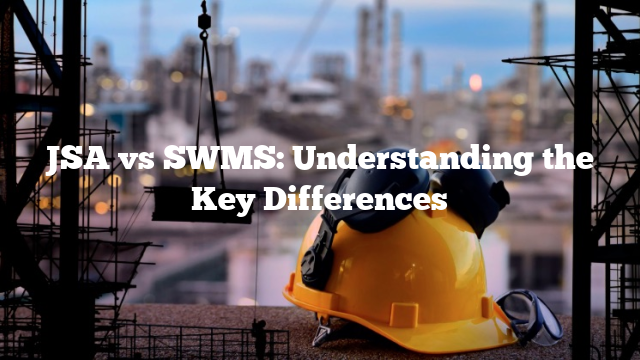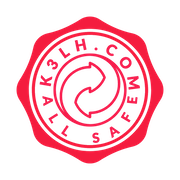JSA vs SWMS: Understanding the Key Differences

Difference Between JSA and SWMS: A Comprehensive Guide
Are you familiar with the terms JSA and SWMS? These are two important safety documents that are often used in workplaces to ensure the safety of employees and prevent accidents. However, many people are confused about the difference between them. In this article, we will explore the difference between JSA and SWMS and understand their importance in creating a safe work environment.
What is JSA?
JSA stands for Job Safety Analysis. It is a safety document that is used to identify potential hazards associated with a particular job or task. JSA is a systematic approach to identify and analyze potential hazards and risks associated with a job. It involves breaking down a job into smaller tasks and analyzing each task to identify potential hazards. The goal of JSA is to identify potential hazards and develop control measures to mitigate them.
What is SWMS?
SWMS stands for Safe Work Method Statement. It is a safety document that outlines the steps that need to be taken to complete a particular job or task safely. SWMS is a detailed document that outlines the hazards associated with a job or task, the control measures that need to be implemented, and the personal protective equipment (PPE) that needs to be used. The purpose of SWMS is to ensure that all workers involved in a job or task understand the hazards and risks associated with it and take appropriate measures to mitigate them.
Difference Between JSA and SWMS
Although JSA and SWMS are both safety documents, there are some key differences between them. Here are some of the main differences between JSA and SWMS:
1. Scope: JSA is more focused on identifying potential hazards associated with a particular job or task, while SWMS is more focused on outlining the steps that need to be taken to complete a job or task safely.
2. Detail: JSA is less detailed than SWMS. It focuses on identifying potential hazards and developing control measures to mitigate them. SWMS, on the other hand, is a more detailed document that outlines the hazards associated with a job or task, the control measures that need to be implemented, and the PPE that needs to be used.
3. Purpose: The purpose of JSA is to identify potential hazards and develop control measures to mitigate them. The purpose of SWMS is to ensure that all workers involved in a job or task understand the hazards and risks associated with it and take appropriate measures to mitigate them.
Tutorial of Difference Between JSA and SWMS
Now that we know the difference between JSA and SWMS, let’s take a closer look at each one and understand how they work.
JSA Tutorial
1. Define the job or task: The first step in conducting a JSA is to define the job or task that needs to be analyzed. This involves breaking down the job into smaller tasks and identifying the hazards associated with each task.
2. Identify potential hazards: The next step is to identify potential hazards associated with each task. This involves looking at the equipment, materials, and environment associated with each task and identifying potential hazards.
3. Analyze the hazards: Once potential hazards have been identified, the next step is to analyze them. This involves looking at the likelihood and severity of the hazard and determining the best way to control or mitigate it.
4. Develop control measures: The final step in conducting a JSA is to develop control measures to mitigate the identified hazards. This can include implementing engineering controls, administrative controls, or providing PPE to workers.
SWMS Tutorial
1. Define the job or task: The first step in developing a SWMS is to define the job or task that needs to be completed. This involves breaking down the job into smaller tasks and identifying the hazards associated with each task.
2. Identify potential hazards: The next step is to identify potential hazards associated with each task. This involves looking at the equipment, materials, and environment associated with each task and identifying potential hazards.
3. Develop control measures: Once potential hazards have been identified, the next step is to develop control measures to mitigate the identified hazards. This can include implementing engineering controls, administrative controls, or providing PPE to workers.
4. Outline the steps: The final step in developing a SWMS is to outline the steps that need to be taken to complete the job or task safely. This involves outlining the sequence of tasks, the PPE that needs to be used, and the control measures that need to be implemented.
Tips of Difference Between JSA and SWMS
Here are some tips to help you understand the difference between JSA and SWMS:
1. Conduct a JSA to identify potential hazards associated with a particular job or task.
2. Develop a SWMS to outline the steps that need to be taken to complete a job or task safely.
3. Use JSA to identify potential hazards and develop control measures to mitigate them.
4. Use SWMS to ensure that all workers involved in a job or task understand the hazards and risks associated with it and take appropriate measures to mitigate them.
Question and Answer of Difference Between JSA and SWMS
1. What is the main difference between JSA and SWMS?
JSA is focused on identifying potential hazards associated with a particular job or task, while SWMS is focused on outlining the steps that need to be taken to complete a job or task safely.
2. When should you conduct a JSA?
You should conduct a JSA whenever you are starting a new job or task or when there are changes to an existing job or task.
3. When should you develop a SWMS?
You should develop a SWMS before starting a job or task to ensure that all workers involved in the job or task understand the hazards and risks associated with it and take appropriate measures to mitigate them.
4. What is the purpose of JSA and SWMS?
The purpose of JSA is to identify potential hazards and develop control measures to mitigate them. The purpose of SWMS is to ensure that all workers involved in a job or task understand the hazards and risks associated with it and take appropriate measures to mitigate them.
Conclusion of Difference Between JSA and SWMS
In conclusion, JSA and SWMS are both important safety documents that are used in workplaces to ensure the safety of employees and prevent accidents. Although they are similar in some ways, they have some key differences that set them apart. By understanding the difference between JSA and SWMS, you can create a safe work environment and prevent accidents. So, always remember to conduct a JSA to identify potential hazards and develop control measures to mitigate them, and develop a SWMS to ensure that all workers involved in a job or task understand the hazards and risks associated with it and take appropriate measures to mitigate them.
Advertisement
Scroll to Continue With Content


